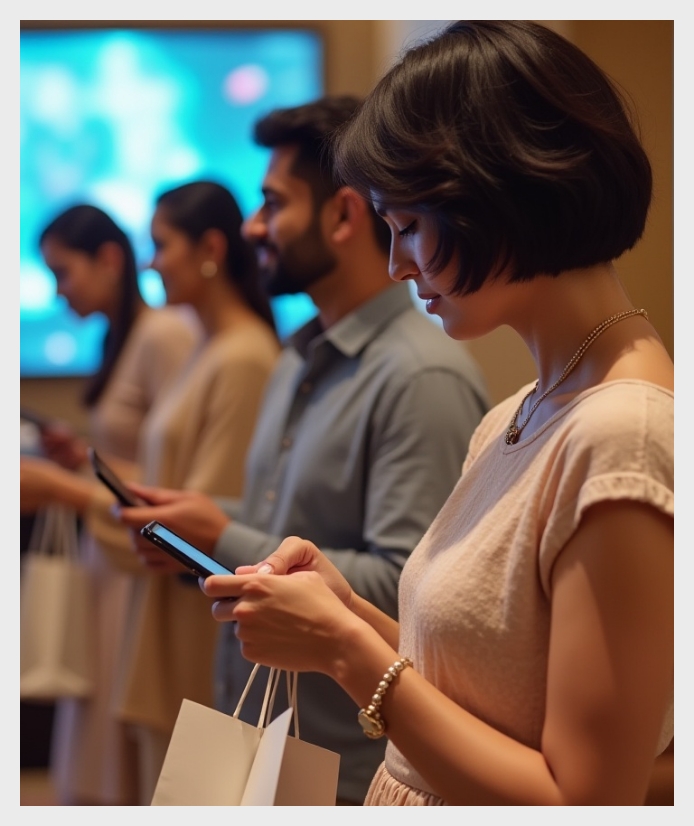
WEDDING PLANNING
SAVE DATE
RSVP ETIQUETTE

Why Do So Many Guests Ignore RSVPs? (And What You Can Do About It)
Topics
It starts innocently. A couple spends hours crafting a guest list, creating a gorgeous invite, and sending it off — digital, printed, or lovingly hand-delivered. And then… silence. Days pass. Weeks. A few people respond immediately, mostly close friends or those obsessively organized. But the rest? Nothing.
If you’ve ever planned an Indian wedding, you know this pain. The unanswered RSVP is more than a missing checkbox. It’s uncertainty about food, rooms, logistics, and — perhaps most frustratingly — respect for the energy you’ve poured into the biggest celebration of your life.
So why do guests ghost the RSVP? And more importantly, what can couples do to turn that tide?
Why RSVP Really Matters
Let’s be honest: you’re not asking guests to build a rocket. You’re simply asking for clarity — a yes, no, or maybe. So why does this simple step ma er so much? Because weddings are no longer the open- ended free-for-alls of decades past. Every function — whether it’s the Haldi at home, the Sangeet at a farm venue, or the Reception at a luxury hotel — involves planning, budgeting, and headcounts. Caterers need final numbers. Hotels need rooming lists. Transportation teams need to know who’s arriving when. And the couple? They deserve to know how many chairs to set out for the biggest moment of their lives.
Beyond logistics, RSVP information helps with emotional preparation too. Who’s coming to bless the couple? Who isn’t? It shapes not just the guest experience but the hosts’ experience as well.

It also prevents awkward last-minute crises: running out of food, scrambling for extra plates, not having enough welcome kits, or worse — wasting money on extras no one uses. An RSVP is not just a formality. It’s a sign of mutual respect. It tells the couple: “Your wedding ma ers to me. So does your time.
The Cultural Blind Spot
Part of the problem lies in how Indian weddings have traditionally operated. For decades, invites were verbal. “You must come!” was an open-ended declaration from uncle to neighbor, friend to cousin. The concept of confirming a endance simply didn’t exist. You showed up. Sometimes you brought four more people. Sometimes you didn’t come at all — and no one really tracked it.
As Indian weddings have grown in scale and complexity — with carefully curated guest lists, plated dinners, limited hotel rooms, and destination logistics — the need for accurate headcounts has never been greater. But culturally, many families still operate in a “sab chalta hai” mode. The expectation to RSVP hasn’t caught up with the sophistication of modern wedding planning.
The Modern Distraction
The other culprit? Digital overwhelm. Your beautifully designed invite gets lost between a work email and a grocery sale notification. Guests forget, procrastinate, or assume they’ll “tell you in person.” Some wait until they’ve confirmed travel or discussed with family. Others worry that RSVP-ing “no” might be seen as rude, so they avoid responding altogether.
And then there’s the dreaded ambiguity: “What if I RSVP yes now but something comes
up?” That discomfort leads to silence.
All of it leaves couples and families hanging — unable to plan food, rooms, transportation,
or seating. The emotional toll is real. Planning a wedding is already a high-stress, high-
stakes endeavor. Not knowing whether 200 or 350 people are coming can make you want
to scream into a pile of guest cards.
But here’s the good news: It doesn’t have to be this way. Make It Easy (and Polite) to Say Yes or No
The key to be er RSVPs is creating a process that is frictionless, respectful, and — above all — guest-friendly.
Ditch the awkward Google Forms or “Just reply to this WhatsApp” chaos. Instead, use a system that gives every guest a personalized RSVP experience. One where they see only the events they’re invited to, can RSVP for each one with a single tap, and update their responses if plans change.
The best platforms even allow guests to include names of plus-ones, family members, or dietary preferences — all in one place. No follow-ups. No guessing.
And for guests who still “forget,” automated reminders (sent gently, not naggingly) can nudge them to respond — without you becoming the RSVP police.
Add a Human Touch
Technology can do a lot, but so can tone. When sending out your invites or messages, don’t just drop a link. Add a personal note:
“We’re so excited to celebrate with you! It would help us immensely to know which events you’ll be joining. Please RSVP at the link so we can plan with love (and enough biryani).”
A li le warmth goes a long way. It shifts the RSVP from a formal checkbox to a heartfelt request. You’re not asking for logistics — you’re inviting them into a moment that ma ers.

Track Smartly. Plan Confidently.
Once RSVPs start coming in, don’t scramble with spreadsheets. Use a tool that gives you live updates, summaries by event, and even travel information for each guest. When you know who’s coming to which function, when they’re arriving, and where they’re staying, you can plan with clarity.
From hotel room allocations to vendor counts, you make be er decisions — and save money, time, and stress.

The Unexpected Benefit: Guests Feel More Valued
Here’s what most couples don’t realize: when guests are asked to RSVP through a smooth, personal system, they feel more seen. More included. They’re not one of hundreds on a generic list. They’ve been given their own space in your wedding story.
And that feeling of being personally welcomed? That’s what makes guests show up with excitement — and stay connected throughout the celebration.
Summary
RSVP silence isn’t about rudeness — it’s about a cultural gap, modern overwhelm, and clunky systems. But the RSVP itself? It ma ers more than most couples — and guests — realize. It’s the cornerstone of great planning, smooth logistics, and a thoughtful guest experience.
The solution isn’t to chase people down. It’s to meet them where they are: with technology that’s respectful, intuitive, and kind. When you make it easy for guests to say “yes,” everyone shows up be er — for the celebration, and for each other.

